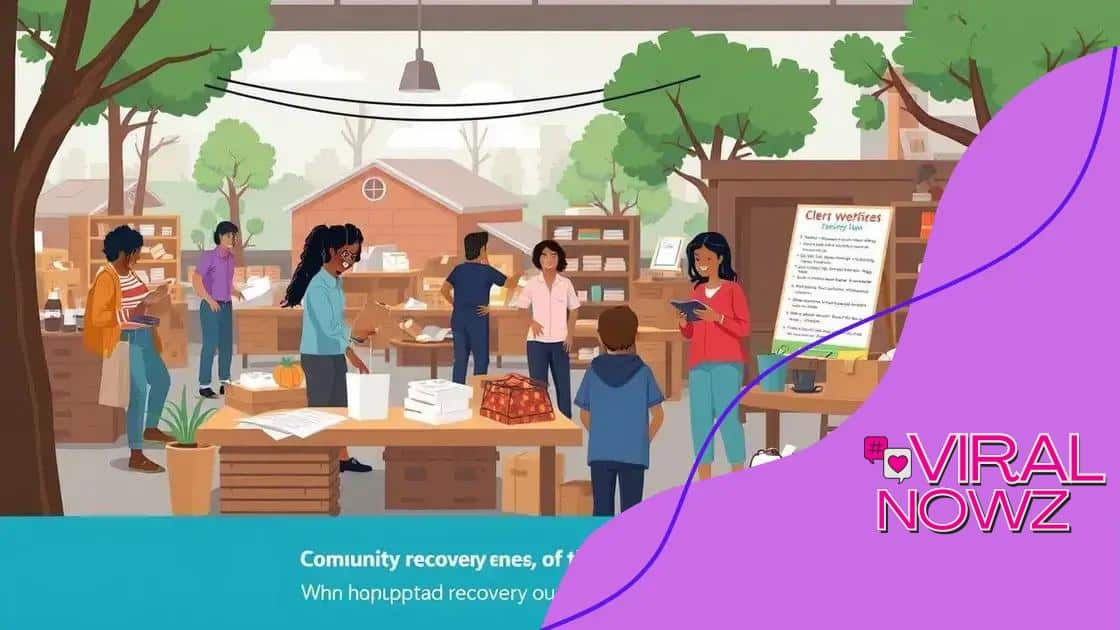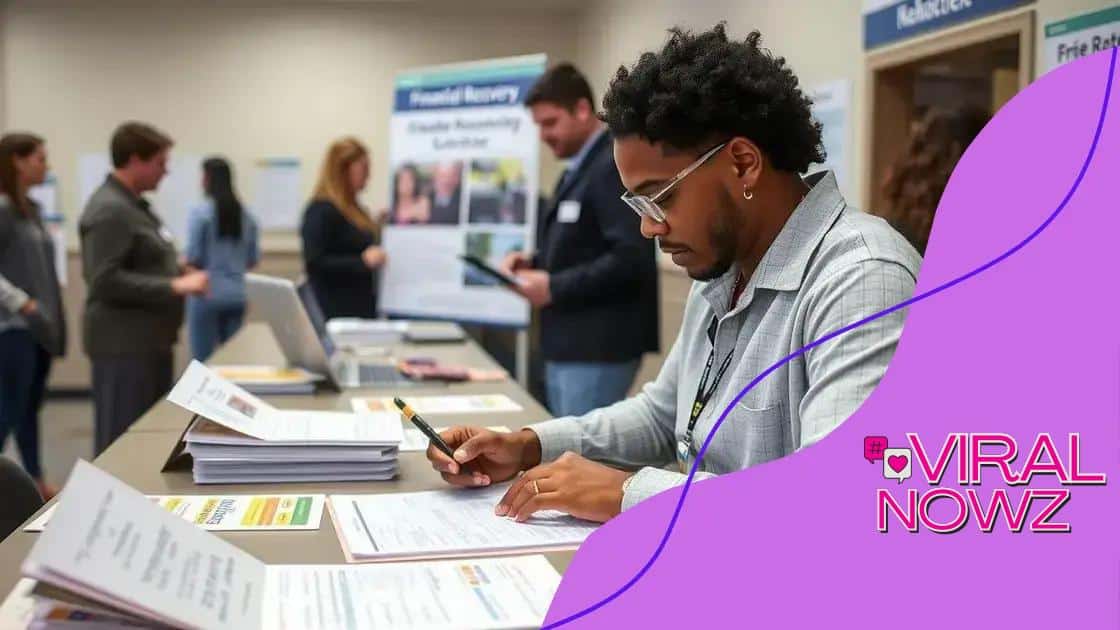Financial relief during natural disasters: what you need to know

Financial relief during natural disasters includes assistance programs that provide housing support, food resources, and medical expense coverage, essential for recovery and rebuilding after such events.
Financial relief during natural disasters is crucial for affected individuals and families. Have you ever wondered about the support available when calamities strike? This article aims to unveil various resources and programs that can aid in your recovery journey.
Understanding the impact of natural disasters on finances
Natural disasters can strike unexpectedly, causing significant disruptions in people’s lives. Understanding the impact of natural disasters on finances is crucial for recovery. Whether it’s a flood, hurricane, or wildfire, these events can lead to immediate and long-term financial challenges.
Immediate Financial Effects
When a natural disaster occurs, there are immediate costs that families and individuals face. Emergency repairs, temporary housing, and replacing lost items can quickly add up. This initial financial burden can be overwhelming, making it hard for many to cope.
Moreover, many people find their income disrupted. If businesses close or are damaged, workers may lose their jobs or see reduced hours. Understanding these financial strains is vital.
Long-term Financial Consequences
The long-term effects often include debt accumulation. As costs rise, families may rely on credit cards and loans to cover expenses. This can lead to a cycle of debt that is challenging to escape.
Additionally, insurance claims can take time to process. Many individuals face waiting periods that intensify financial stress. It’s essential to understand what your insurance policy covers and how to navigate these claims effectively.
- Loss of property value
- Increased susceptibility to rising costs
- Need for financial planning and budgeting
- Potential legal issues regarding claims
Also, communities may see a decline in local businesses, resulting in fewer job opportunities and economic growth. This also affects public services and social programs, which can hinder recovery efforts.
Managing Financial Stress
During these tough times, it’s essential to take proactive steps. Creating a budget that considers unexpected costs can help you stay afloat. Prioritize essential expenses, such as housing and food.
Moreover, reaching out to community organizations for support can provide relief. Many local and national organizations offer assistance to help individuals regain their financial footing after a disaster.
Government assistance programs during disasters
During natural disasters, government assistance programs play a vital role in helping affected individuals and families recover. These programs are designed to provide financial support and essential resources to those in need. Understanding these options can make a significant difference in recovery efforts.
Types of Government Assistance
One of the major forms of support comes from the Federal Emergency Management Agency (FEMA). This agency offers various types of assistance, including:
- Housing assistance for temporary or permanent housing needs
- Disaster-related medical and dental expenses
- Personal property replacement costs
- Funds for transportation and other basic needs
In addition to FEMA, state and local governments may also offer their own programs. These can vary greatly, but many include direct aid and resources tailored to specific community needs.
It’s important to note that many of these programs have specific eligibility requirements. For instance, individuals must apply for assistance within a set timeframe after a disaster occurs. This process can sometimes be complex, which is why understanding the requirements is crucial.
How to Access Assistance
Accessing government assistance typically involves filling out applications and providing necessary documentation. Gathering documents like identification, proof of residence, and information about the disaster’s impact can speed up this process.
Residents can often apply online, by phone, or in person at designated disaster recovery centers. Community organizations can also assist in navigating these applications, ensuring that individuals don’t miss out on potential aid. It is beneficial to stay informed through official government websites and local news for updates on available programs.
How to apply for financial relief

Applying for financial relief after a natural disaster can be a daunting task. Understanding the process can ease some of the stress associated with recovery. It’s essential to know what steps to take to ensure you receive the assistance you need.
Gather Necessary Documents
The first step in applying for aid is to collect important documents. This may include:
- Identification: Such as a driver’s license or ID card
- Proof of residence: Utility bills or lease agreements
- Insurance information: Details about your current insurance policies
- Financial records: Bank statements and income details
Having these prepared will help streamline your application process and avoid potential delays.
Understand Different Application Methods
There are various ways to apply for financial relief. Many organizations, including FEMA, offer online applications, phone applications, and in-person assistance at disaster recovery centers. It’s essential to choose the method that works best for you.
When applying online, make sure you have a reliable internet connection. If you choose to apply by phone, keep all your documents nearby to answer questions promptly. If you decide to go in person, look for a local recovery center for assistance.
Fill Out Your Application
When completing your application, be accurate and thorough. Provide as much detail as possible about the damages and the assistance you need. Ensure to check your application for errors before submitting it.
If you need help, consider reaching out to local organizations or community groups. Volunteers are often available to assist individuals in completing their applications.
After submitting your application, keep a record of it for your reference. Make a note of any confirmation numbers or important details, as this will help you track the status of your assistance request.
Tips for managing expenses post-disaster
After a natural disaster, managing your expenses becomes crucial for recovery. Being proactive can help you regain control over your finances. Each step is vital to ensure your financial stability during this challenging time.
Assess Your Financial Situation
Begin by evaluating your current financial status. Make a list of your income sources and expenses. Understanding what you have coming in versus what goes out will help you make informed decisions moving forward.
Be sure to include all fixed expenses like rent or mortgage, utilities, and any existing debts you may have.
Create a New Budget
Once you have assessed your finances, it’s time to create a revised budget. Focus on essential expenses first. List out:
- Housing costs: This includes rent or mortgage payments.
- Utilities: Electricity, water, and gas bills.
- Food: Prioritize low-cost, nutritious options.
- Transportation: Consider using public transport if possible.
By prioritizing these expenses, you can regain control over your financial situation during recovery.
Seek Community Resources
Don’t hesitate to seek help from local organizations and community resources. Many provide assistance with food, shelter, and financial aid. Connecting with community support can ease financial burdens and help you find necessary resources.
You can also reach out to friends and family for temporary support. Sometimes, they can help you cover basic living expenses as you get back on your feet.
Community resources for ongoing support
After a natural disaster, community resources become a lifeline for many individuals and families. These resources offer ongoing support to help you recover and rebuild your life. Understanding what is available can make a big difference in your recovery journey.
Types of Community Resources
Local organizations and charities often provide various forms of assistance. Some common resources include:
- Food pantries: These provide essential food items to families in need.
- Shelters: Local shelters can offer temporary housing for those displaced.
- Counseling services: Mental health support is crucial after a disaster, and many communities offer free or low-cost counseling.
- Financial aid programs: These can assist with expenses like utilities, rent, and medical bills.
These organizations often work together to ensure you receive the help you need, making it easier to access multiple services.
How to Find Community Resources
Finding the right resources can sometimes be challenging. Start by contacting local government agencies or visiting their websites. They often have lists of available services. Additionally, local libraries and community centers may provide information on available resources.
Social media can also be a valuable tool. Many community organizations share updates and information online. Following these groups can keep you informed about new programs and support options.
Don’t hesitate to reach out directly to organizations. Calling or visiting them can provide more personalized information based on your specific needs. It’s essential to advocate for yourself and seek the support available.
FAQ – Questions About Financial Relief and Community Support After Disasters
What types of financial relief are available after a disaster?
Financial relief can include housing assistance, food aid, medical expenses coverage, and personal property replacement. Various programs are offered by government agencies and non-profits.
How can I find community resources for support?
You can find resources by contacting local government offices, checking community centers, or visiting online platforms of local organizations that specialize in disaster recovery.
What documents do I need to apply for financial assistance?
Typically, you will need identification, proof of residence, insurance information, and any related financial records to complete your application.
How do I create a budget after a disaster?
Start by assessing your income and essential expenses, then prioritize housing, food, and utility costs. Adjust your budget as necessary to reflect your current situation.





